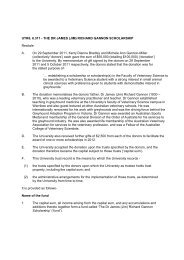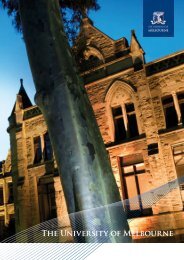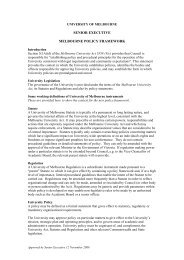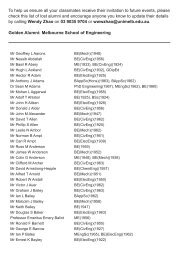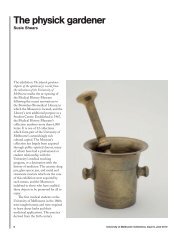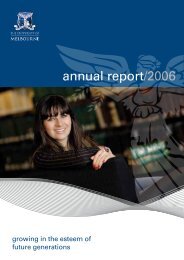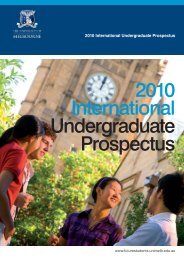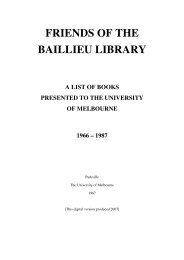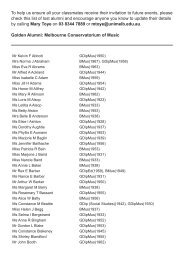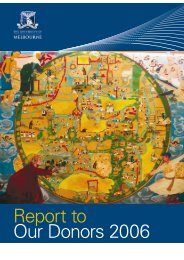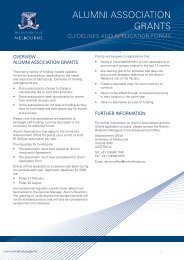2007 Annual report (PDF 8.1 Mb) - University of Melbourne
2007 Annual report (PDF 8.1 Mb) - University of Melbourne
2007 Annual report (PDF 8.1 Mb) - University of Melbourne
You also want an ePaper? Increase the reach of your titles
YUMPU automatically turns print PDFs into web optimized ePapers that Google loves.
NOTES TO AND FORMING PART OF THE<br />
FINANCIAL STATEMENTS FOR THE YEAR ENDED 31 DECEMBER <strong>2007</strong><br />
NOTE 1: STATEMENT OF SIGNIFICANT ACCOUNTING POLICIES (CONTINUED)<br />
(viii) Leasehold Improvements<br />
Recorded in the Balance Sheet at cost less amortisation and where applicable, any impairment losses. Improvements costing<br />
$10,000 or more are capitalised with expenditure less than $10,000 being expensed.<br />
(ix)<br />
(x)<br />
(xi)<br />
Construction in Progress<br />
Recorded in the Balance Sheet at cost.<br />
Subsequent Costs<br />
The costs <strong>of</strong> the day-to-day servicing <strong>of</strong> property, plant and equipment are recognised in the Income Statement in the period in which<br />
they are incurred.<br />
Depreciation<br />
Depreciation is provided on a straight line basis on all tangible fixed assets other than Land, Construction in Progress, Works <strong>of</strong> Art<br />
and Other Collections none <strong>of</strong> which are depreciated.<br />
Major Depreciation Rates are:<br />
Buildings 3%<br />
Motor Vehicles 20%<br />
Furniture and Equipment<br />
- Furniture, Fixtures and Fittings 10%<br />
- Communications Equipment 12½%<br />
- General Equipment 25%<br />
- Scientific and Computing Equipment<br />
- Large Research Equipment 20%<br />
- Other Scientific and Computing Equipment 33 %<br />
Leasehold Improvements (amortised over the term <strong>of</strong> the lease)<br />
Library Collection:<br />
- Monographs 2½%<br />
- Periodicals 2%<br />
These rates have been consistently maintained and there has been no change from rates applied in prior years with exception to<br />
Large Research Equipment as disclosed in Note 1.25. Depreciation rates used by some subsidiaries vary slightly from the rates<br />
stated above.<br />
Acquisitions are depreciated from the date <strong>of</strong> purchase; disposals are depreciated up to the date <strong>of</strong> sale or when classified as heldfor-sale<br />
(refer to Note 1.15).<br />
1.12 Intangible Assets<br />
(i) Research<br />
Expenditure on research activities is recognised in the Income Statement as an expense when it is incurred.<br />
(ii) Goodwill<br />
Goodwill on acquisition is initially measured at cost being the excess <strong>of</strong> the cost <strong>of</strong> the business combination over the acquirer’s interest<br />
in the net fair value <strong>of</strong> the identifiable assets, liabilities and contingent liabilities. Following initial recognition, goodwill is measured at<br />
cost less any accumulated impairment losses. At 31 December <strong>2007</strong>, the consolidated entity had no goodwill (2006, Nil).<br />
(iii)<br />
S<strong>of</strong>tware<br />
Major computer s<strong>of</strong>tware is recorded in the Balance Sheet at cost less amortisation and where applicable, any impairment losses.<br />
Only the cost <strong>of</strong> the s<strong>of</strong>tware is capitalised, installation costs are expensed in the Income Statement in the year they are incurred.<br />
Amortisation is provided on a straight line basis at the rate <strong>of</strong> 33 %. There has been no change in the amortisation rate from the<br />
prior year.<br />
1.13 Revaluation <strong>of</strong> Non Current Assets<br />
AASB 116 Property, Plant and Equipment requires <strong>report</strong>ing entities to measure assets within each class <strong>of</strong> non-current asset on either the<br />
cost basis or on a fair value basis. Subsequent to initial recognition, non-current physical assets, other than furniture and equipment, motor<br />
vehicles, leasehold improvements, the library collection and intangible assets, are measured at fair value.<br />
In accordance with the not-for-pr<strong>of</strong>it requirements <strong>of</strong> AASB 116, revaluation increments are credited directly to the asset revaluation<br />
reserve, except that, to the extent that an increment reverses a revaluation decrement in respect <strong>of</strong> that class <strong>of</strong> asset previously<br />
recognised as an expense in the net result, the increment is recognised as income in the net result.<br />
Revaluation decrements are recognised immediately as expenses in the net result, except that, to the extent that a credit balance exists in<br />
the asset revaluation reserve in respect <strong>of</strong> the same class <strong>of</strong> assets, they are debited directly to the asset revaluation reserve.<br />
Revaluation increments and decrements relating to individual assets within a class <strong>of</strong> property, plant and equipment are <strong>of</strong>fset against one<br />
another within that class but are not <strong>of</strong>fset in respect <strong>of</strong> assets in different classes. Revaluation reserves are not transferred to retained<br />
earnings on derecognition <strong>of</strong> the relevant asset.






